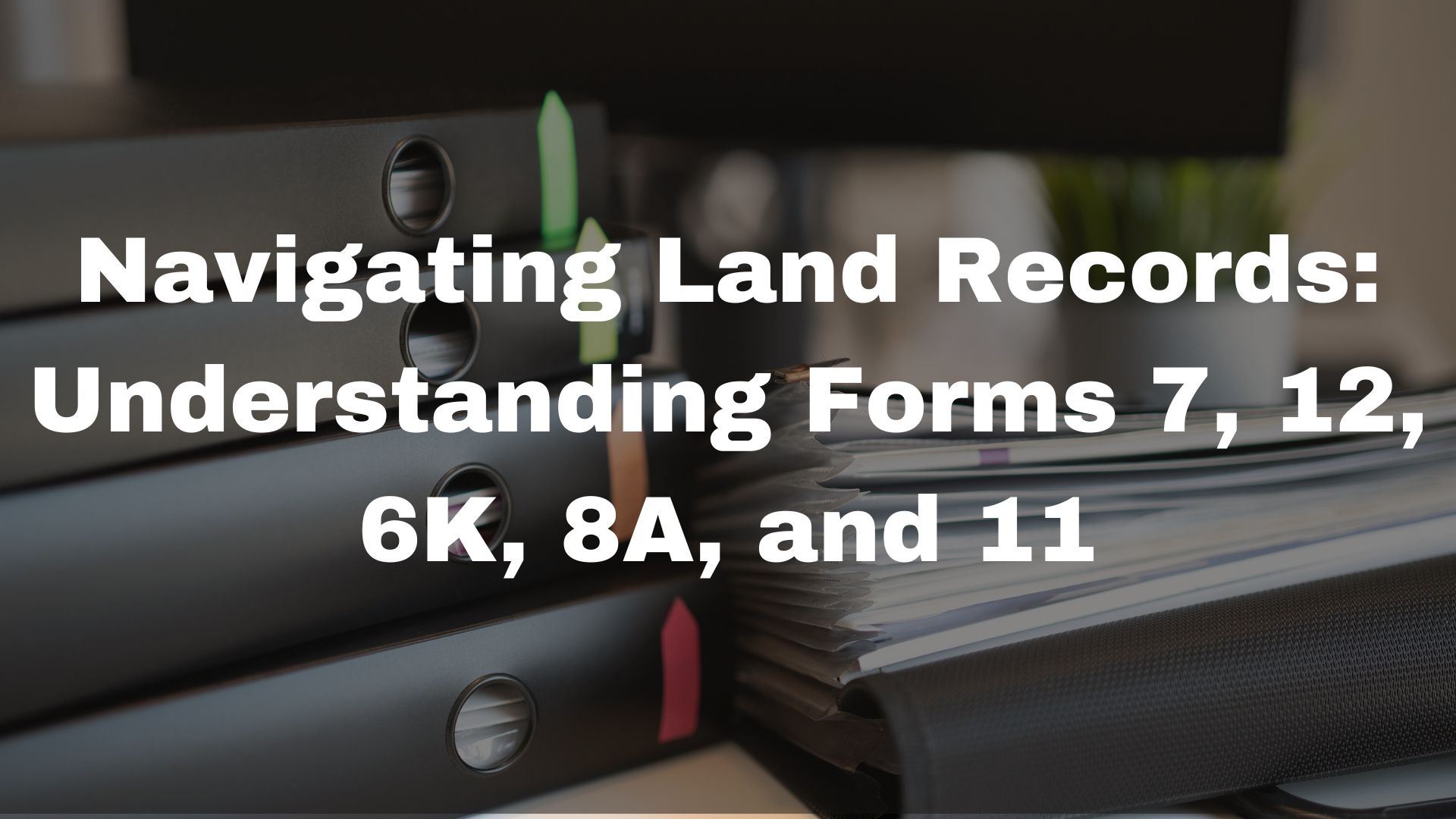
Navigating Land Records: Understanding Forms 7, 12, 6K, 8A, and 11
Land records are essential legal documents establishing ownership, land use, and other immovable property rights. Understanding these records is crucial for property transactions, legal claims, agricultural benefits, and government schemes. In India, land records are maintained by state governments and can include various forms such as Forms 7, 12, 6K, 8A, and 11. Each document serves a distinct purpose, ensuring proper documentation and transparency in land ownership.
This article provides an in-depth understanding of these land record forms, their importance, and how they facilitate land administration.
Basics of Land Records
Land records primarily contain details such as:
-
Ownership History
-
Land area and boundaries
-
Type of land (agricultural, non-agricultural, commercial, etc.)
-
Encumbrances, if any
-
Revenue obligations
Maintaining updated and accurate land records helps resolve disputes, facilitate taxation, promote urban planning, and secure loans against land assets.
Understanding Forms 7, 12, 6K, 8A, and 11
1. Form 7 (Land Dispute & Tenancy Record)
Form 7 is used to file claims for tenancy rights under land reform laws. It helps tenants establish their rights over agricultural land and is a legal document in disputes between landlords and tenants.
2. Form 12 (Village Form for Land Register)
Form 12 is a crucial document containing details on land ownership, classification, and tax obligations. It helps landowners verify and maintain their property records while ensuring compliance with revenue laws.
3. Form 6K (Mutation Register)
Mutation refers to the transfer of ownership rights after inheritance, sale, or gift. Form 6K records these changes in the revenue register, ensuring that the rightful owner is updated in government records.
4. Form 8A (Land Account Form)
Form 8A provides a summary of land ownership and tax payments. Landowners use it to track their dues, and government authorities use it to assess land revenue.
5. Form 11 (Record of Rights)
Form 11, the Record of Rights (RoR), is a comprehensive document that establishes ownership, liabilities, and tenancy details. It is required for property transactions, loan obtaining, and dispute resolution.
Importance of Land Records
-
Legal Proof of Ownership: Land records establish rightful ownership, reducing conflicts and fraud.
-
Ease of Transactions: Clear records facilitate smooth property transactions, including sales and mortgages.
-
Government Schemes & Benefits: Many agricultural and welfare schemes require documented proof of land ownership.
-
Urban & Rural Planning: Authorities use land records for infrastructure development and city planning.
-
Tax Assessment & Collection: Proper documentation ensures the correct assessment and collection of land taxes.
-
Dispute Resolution: Land records are crucial in settling ownership disputes in courts and revenue offices.
How to Access Land Records?
Most states in India have digitised land records, making them accessible online. Landowners can visit their state revenue department’s official website, enter necessary details (survey number, village name, district), and obtain copies of these records.
Closing Remarks
Understanding Forms 7, 12, 6K, 8A, and 11 is crucial for landowners, tenants, and stakeholders involved in land transactions. These records serve as legal proof of ownership, facilitate transactions, and help avail government benefits. With the digitalisation of land records, accessing and updating them has become more convenient, ensuring transparency and efficiency in land administration.
In case of any query regarding Navigating Land Records: Understanding Forms 7, 12, 6K, 8A, and 11, feel free to connect with our legal experts, Tulja Legal, at +91 96380-69905
About the Author
Anju S Nair
Legal Researcher | LLB, MA English| Corporate Lawyer | Business Enthusiast | Founder & CEO at iLawbook.
FAQs
1. Why are land records vital?
Land records establish ownership, help in taxation, facilitate loans, and prevent disputes.
2. How can I get a copy of my land record?
You can obtain land records from the local revenue office or the state government’s online portal.
3. What is Form 7 used for?
Form 7 is used for tenancy claims and dispute resolution related to land reforms.
4. How is mutation recorded in land records?
Mutation is recorded using Form 6K, which updates the ownership details in revenue records after a property transfer.
5. Can I apply for a loan using Form 11?
Yes, Form 11 (Record of Rights) is proof of ownership and is often required for loan applications.
6. Is Form 12 mandatory for land registration?
Yes, Form 12 contains ownership details and tax obligations, making it essential for land registration.
7. How often should land records be updated?
Land records should be updated whenever there is a change in ownership, partition, or significant change in land use.
8. What if my land record contains errors?
You should apply for corrections at the local revenue office by submitting relevant proof of ownership and identification.
9. Can non-agricultural land be recorded under these forms?
Some forms, like Form 11 and Form 12, apply to agricultural and non-agricultural land, while others are specific to agricultural properties.
10. Are digital land records legally valid?
Digital land records are legally valid, provided the authorised state government portal issues them.
References
-
Government of India Revenue Department Official Website
-
State Land Records Portals (e.g., Maharashtra Bhulekh, Karnataka Bhoomi)
-
National Informatics Centre (NIC) - Land Records Digitization Initiative
-
Legal Framework on Land Tenure in India - Ministry of Rural Development
-
Various State Government Acts & Land Revenue Codes
